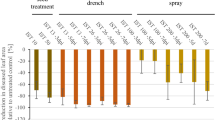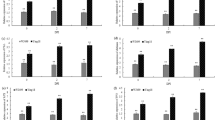Abstract
Blast fungus (Magnaporthe oryzae B.C. Couch) is an imminent threat to global food security because it causes serious yield losses in rice (Oryza sativa L.) and wheat (Triticum aestivum L.). The investigation of infection processes in resistant and susceptible varieties, as well as the cellular responses involved in resistance, can help us to better understand the process of interaction of the M. oryzae-Poaceae pathosystems. Thus, the objectives of this study were to evaluate the processes of pre- and post-infection of M. oryzae in leaves of wheat varieties with different levels of resistance. The percentage of germinated conidia, appressorium formed, tissue penetration and colonization, and the reaction of leaf tissue to infection were evaluated. A decrease was observed in the percentage of germinated conidia, appressorium formation, tissue penetration and colonization, especially in the tissues of resistant varieties, in addition to an increase in the plant’s response to infection, with cell wall reinforcement, cell death, and autofluorescent cytoplasm aggregation. Nevertheless, our data produced a different temporal perspective regarding the expression of the known types of resistance. We found that, for a single genotype, recognition can start as early as 6 h after inoculation and continue to evolve until very late during the infection cycle, culminating in cell death. The combined and overlapping pre- and post-haustorial resistance mechanisms were sufficient to prevent disease symptoms, with a few punctual lesions observed in one of the resistant varieties (BR 18) and no visible symptoms in the other two (Ônix or BRS229) as opposed to susceptible variety.



Similar content being viewed by others
References
Anh VL, Anh NT, Tagle AG, Vy TTP, Inoue Y, Takumi S, Chuma I, Tosa Y (2015) Rmg8, a new gene for resistance to Triticum isolates of Pyricularia oryzae in hexaploid wheat. Phytopathology 105:1568–1572. https://doi.org/10.1094/PHYTO-02-15-0034-R
Anh VL, Inoue Y, Asuke S, Vy TTP, Anh NT, Wang S, Chuma I, Tosa Y (2017) Rmg8 and Rmg7, wheat genes for resistance to the wheat blast fungus, recognize the same avirulence gene AVR-Rmg8. Mol Plant Pathol 19:1252–1256. https://doi.org/10.1111/mpp.12609
Araújo L, Soares JM, De Filippi MCC, Rodrigues FA (2016) Cytological aspects of incompatible and compatible interactions between rice, wheat and the blast pathogen Pyricularia oryzae. Sci Agric 73:177–183. https://doi.org/10.1590/0103-9016-2015-0169
Assaad FF, Qiu J, Youngs H, Ehrhardt D, Zimmerli L, Kalde M (2004) The PEN1 syntaxin defines a novel cellular compartment upon fungal attack and is required for the timely assembly of papillae. Mol Biol Cell 15:5118–5129. https://doi.org/10.1091/mbc.e04-02-0140
Barea G, Toledo J (1996) Identificación y zonificación de piricularia o bruzone (Pyricularia oryzae) en el cultivo del trigo en el dpto. de Santa Cruz. CIAT. Informe Técnico. Proyecto de Investigación Trigo, Santa Cruz, pp 76–86.
Casassola A, Brammer SP, Chaves MS, Martinelli JÁ, Stefanato F, Boyd LA (2015) Changes in gene expression profiles as they relate to the adult plant leaf rust resistance in the wheat cv. Toropi Physiol Mol Plant Pathol 89:49–54. https://doi.org/10.1016/j.pmpp.2014.12.004
Collins NC, Thordal-Christensen H, Lipka V, Bau S, Kombrinck E, Qiu JL, Hückelhoven R, Stein M, Freialdenhoven A, Somerville SC, Schulze-Lefert P (2003) Snare-protein-mediated disease resistance at plant cell wall. Nature 425:973–1007
Cruz CD, Bockus WW, Stack JP, Tang X, Valent B, Pedley KF, Peterson GL (2012) Preliminary assessment of resistance among U.S. wheat cultivars to the Triticum pathotype of Magnaporthe oryzae. Plant Dis 96:1501–1505. https://doi.org/10.1094/PDIS-11-11-0944-RE
Cruz CD, Kiyuna J, Bockus WW, Todd TC, Stack JP, Valent B (2015) Magnaporthe oryzae conidia on basal wheat leaves as a potential source of wheat blast inoculum. Plant Pathol 64:1491–1498. https://doi.org/10.1111/ppa.12414
Cruz CD, Valent B (2017) Wheat blast disease: danger on the move. Trop Plant Pathol 42:210–222. https://doi.org/10.1007/s40858-017-0159-z
Cumagun CJR, Anh VL, Vy TTP, Inoue Y, Asano H, Hyon GS, Chuma I, Tosa Y (2014) Identification of a hidden resistance gene in tetraploid wheat using laboratory strains of Pyricularia oryzae produced by backcrossing. Phytopathology 104:634–640. https://doi.org/10.1094/PHYTO-04-13-0106-R
Cunha GR, Caierão E, Rosa AC (eds) (2016) Informações técnicas para trigo e triticale – safra 2016. Biotrigo Genética, Passo Fundo, RS, Brasil.
Faivre-Rampant O, Thomas J, Allègre M, Morel JB, Tharreau D, Nottéghem JL, Lebrun MH, Schaffrath U, Piffanelli P (2008) Characterization of the model system rice – Magnaporthe for the study of nonhost resistance in cereals. New Phytol 180:899–910. https://doi.org/10.1111/j.1469-8137.2008.02621.x
FAO (2011) Economic and Social Development Department> Food Security Statistics>Data> Food securitydata and definitions>Diet composition> Food consumption pattern of main food items. http://www.fao.org/economic/ess/ess-fs/fs-data/ess-fadata/en/ Accessed 15 June 2011
Feyter RD, Yang Y, Gabriel DW (1993) Gene-for-genes interactions between cotton R genes and Xanthomonas campestris pv. malvacearum avr genes. Mol Plant-Microbe Interact 6:225–237. https://doi.org/10.1094/mpmi-6-225
Gill US, Lee S, Mysore KS (2015) Host versus nonhost resistance: distinct wars with similar arsenals. Phytopathology 105:580–587. https://doi.org/10.1094/PHYTO-11-14-0298-RVW
Graichen FAS, Martinelli JA, de Lima Wesp C, Federizzi LC, Chaves MS (2011) Epidemiological and histological components of crown rust resistance in oat genotypes. Eur J Plant Pathol 131:497–510. https://doi.org/10.1007/s10658-011-9825-z
Gupta DR, Surovy MZ, Mahmud NU, Chakraborty M, Paul SK, Hossain MS, Bhattacharjee P, Mehebub MS, Rani K, Yeasmin R, Rahman M, Islam MT (2020) Suitable methods for isolation, culture, storage and identification of wheat blast fungus Magnaporthe oryzae Triticum pathotype. Phytopathol Res 2:30. https://doi.org/10.1186/s42483-020-00070-x
Hirata K, Tosa Y, Nakayashiki H, Mayama S (2005) Significance of PWT4–Rwt4 interaction in the species specificity of Avena isolates of Magnaporthe oryzae on wheat. J Gen Plant Pathol 71:340. https://doi.org/10.1007/s10327-005-0215-2
Igarashi S, Utiamada CM, Igarashi LC, Kazuma AH, Lopes RS (1986) Pyricularia em trigo. I. Ocorrência de Pyricularia sp. no estado do Paraná. Fitopatol Bras 11:351–352 (Occurrence of Pyricularia sp. in wheat (Triticum aestivum L.) in the State of Paraná, Brazil. Abstract in Portuguese).
Jones K, Kim DW, Park JS, Khang CH (2016) Live-cell fluorescence imaging to investigate the dynamics of plant cell death during infection by the rice blast fungus Magnaporthe oryzae. BMC Plant Biol 16:69. https://doi.org/10.1186/s12870-016-0756-x
McDonald JH (2014) Paired t-test. Handbook of biological statistics. 3rd ed. Sparky House Publishing, Baltimore, MD, USA. Pp. 180–185
MacDonald PL, Gardner RC (2000) Type I error rate comparisons of post hoc procedures for I×J chi-square tables. Educ Psychol Meas 60:735–754. https://doi.org/10.1177/00131640021970871
Maciel JLN, Ceresini PC, Castroagudin VL, Zala M, Kema GHJ, Mcdonald BA (2014) Population structure and pathotype diversity of the wheat blast pathogen Magnaporthe oryzae 25 years after its emergence in Brazil. Phytopathology 104:95–107. https://doi.org/10.1094/PHYTO-11-12-0294-R
Malaker PK, Barma NCD, Tiwari TP, Collis WJ, Duveiller E, Singh PK, Joshi AK, Singh RP, Braun HJ, Peterson GL, Pedley KF, Farman ML, Valent B (2016) First report of wheat blast caused by Magnaporthe oryzae pathotype triticum in Bangladesh. Plant Dis 100:2330–2330
Murakami J, Tosa Y, Kataoka T, Tomita R, Kawasaki J, Chuma I, Sesumi Y, Kusaba M, Nakayashiki H, Mayama S (2000) Analysis of host species specificity of Magnaporthe grisea toward wheat using a genetic cross between isolates from wheat and foxtail millet. Phytopathology 90:1060–1067. https://doi.org/10.1094/PHYTO.2000.90.10.1060
Nelson R, Wiesner-Hanks T, Wisser R, Balint-Kurti P (2018) Navigating complexity to breed disease-resistant crops. Nat Rev Genet 19:21–33. https://doi.org/10.1038/nrg.2017.82
Nga NTT, Hau VTB, Tosa Y (2009) Identification of genes for resistance to a Digitaria isolate of Magnaporthe grisea in common wheat cultivars. Genome 52:801–809. https://doi.org/10.1139/G09-054
Perello A, Martinez L, Molina M (2015) First report of virulence and effects of Magnaporthe oryzae isolates causing wheat blast in Argentina. Plant Dis 99:1177–1178. https://doi.org/10.1094/PDIS-11-14-1182-PDN
Poland JA, Balint-Kurti PJ, Wisser RJ, Pratt RC, Nelson RJ (2009) Shades of gray: the world of quantitative disease resistance. Trends Plant Sci 14:21–29. https://doi.org/10.1016/j.tplants.2008.10.006
Ribot C, Hirsch J, Balzergue S, Tharreau D, Nottéghem JL, Lebrun MH, Morel JB (2008) Susceptibility of rice to the blast fungus, Magnaporthe grisea. J Plant Physiol 165:114–124. https://doi.org/10.1016/j.jplph.2007.06.013
Schulze-Lefert P, Panstruga R (2011) A molecular evolutionary concept connecting nonhost resistance, pathogen host range, and pathogen speciation. Trends Plant Sci 16:117–125. https://doi.org/10.1016/j.tplants.2011.01.001
Sherwood RT, Vance CP (1980) Resistance to fungal penetration in Gramineae. Phytopathology 70:273–279
Tagle AG, Chuma I, Tosa Y (2015) Rmg7, a new gene for resistance to Triticum isolates of Pyricularia oryzae identified in tetraploid wheat. Phytopathology 105:495–499. https://doi.org/10.1094/PHYTO-06-14-0182-R
Takabayashi N, Tosa Y, Oh HS, Mayama S (2002) A gene for gene relationship underlying the species-specific parasitism of Avena/Triticum isolates of Magnaporthe grisea on wheat cultivars. Phytopathology 92(1182):1188. https://doi.org/10.1094/PHYTO.2002.92.11.1182
Tosa Y, Tamba H, Tanaka K, Mayama S (2006) Genetic analysis of host species specificity of Magnaporthe oryzae isolates from rice and wheat. Phytopathology 96:480–484. https://doi.org/10.1094/PHYTO-96-0480
Tufan HA, McGrann GRD, Magusin A, Morel JB, Miche L, Boyd LA (2009) Wheat blast: histopathology and transcriptome reprogramming in response to adapted and nonadapted Magnaporthe isolates. New Phytol 184:476–484. https://doi.org/10.1111/j.1469-8137.2009.02970.x
Underwood W (2012) The plant cell wall: a dynamic barrier against pathogen invasion. Front Plant Sci 3:85. https://doi.org/10.3389/fpls.2012.00085
United Nations (2009) World population prospects: the 2008 revision. United Nations, Department of Economic and Social Affairs, Population Division, New York, USA. CDROM
Valent B, Farrall L, Chumley FG (1991) Magnaporthe grisea genes for pathogenicity and virulence identified through a series of backcrosses. Genetics 127:87–101
Viedma LQ (2005) Wheat blast occurrence in Paraguay. Phytopathology 95:S152
Vy TTP, Hyon GS, Nga NTT, Inoue Y, Chuma I, Tosa Y (2014) Genetic analysis of host-parasite incompatibility between Lolium isolates of Pyricularia oryzae and wheat. J Gen Plant Pathol 80:59–65. https://doi.org/10.1007/s10327-013-0478-y
Wang S, Asuke S, Vy TTP, Inoue Y, Chuma I, Win J, Kato K, Tosa Y (2018) A new resistance gene in combination with Rmg8 confers strong resistance against Triticum isolates of Pyricularia oryzae in a common wheat landrace. Phytopathology 108:1299–1306. https://doi.org/10.1094/PHYTO-12-17-0400-R
Wesp-Guterres C, Martinelli JA, Graichen FAS, Chaves MS (2013) Histopathology of durable adult plant resistance to leaf rust in the Brazilian wheat variety Toropi. Eur J Plant Pathol 137:181–196. https://doi.org/10.1007/s10658-013-0232-5
Yuan M, Jiang Z, Bi G, Nomura K, Liu M, Wang Y, Cai B, Zhou JM, He SY, Xin XF (2021) Pattern-recognition receptors are required for NLR-mediated plant immunity. Nature 592(7852):105–109. https://doi.org/10.1038/s41586-021-03316-6
Zellerhoff N, Jansen M, Schaffrath U (2008) Barley Rom1 antagonizes Rar1 function in Magnaporthe oryzae infected leaves by enhancing epidermal and diminishing mesophyll defence. New Phytol 180:702–710. https://doi.org/10.1111/j.1469-8137.2008.02597.x
Zhan SW, Mayama S, Tosa Y (2008) Identification of two genes for resistance to Triticum isolates of Magnaporthe oryzae in wheat. Genome 51:216–221. https://doi.org/10.1139/G07-094
Zhang HS, De La Rosa R, Rubiales D, Lubbers HH, Molenveld JW, Niks RE (1994) Role of partial resistance to Puccinia hordei in barley in the defence of barley to inappropriate rust fungi. Physiol Mol Plant Pathol 45:219–228. https://doi.org/10.1016/S0885-5765(05)80079-7
Acknowledgements
Thanks are given to Dr. John H. McDonald (University of Delaware, USA) for the assistance in the statistical analysis.
Funding
The authors wish to thank the Conselho Nacional de Desenvolvimento Científico e Tecnológico (CNPq) and Empresa Brasileira de Pesquisa Agropecuária (Embrapa- (Project SEG 02.11.08.004.00.00)) for financial support.
Author information
Authors and Affiliations
Contributions
Conceptualization: Chaves, M.S.; Martinelli, J.A.; Barbieri, M. Data acquisition: Barbieri, M. Data analysis: Barbieri, M.; Chaves, M.S.; Silva, G.B.P. Design of methodology: Chaves, M.S.; Graichen, F.A.S. Writing and editing: Barbieri, M.; Chaves, M.S.; Martinelli, J.A.; Silva, G.B.P.; Graichen, F.A.S.; Torres., G.A.M.
Corresponding author
Additional information
Publisher's note
Springer Nature remains neutral with regard to jurisdictional claims in published maps and institutional affiliations.
Responsible Editor: Aleksander Westphal Muniz
Rights and permissions
About this article
Cite this article
Chaves, M.S., Antunes, M.B., da Silva, G.B.P. et al. Pre and post stage of infection of Magnaporthe oryzae Oryza in wheat leaves with different resistance levels. Braz J Microbiol 53, 1091–1100 (2022). https://doi.org/10.1007/s42770-022-00749-7
Received:
Accepted:
Published:
Issue Date:
DOI: https://doi.org/10.1007/s42770-022-00749-7




